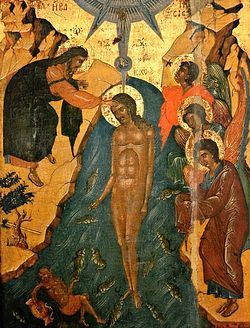SOURCE: Antiochian Orthodox Christian
Archdiocese of North America
Archpriest A. Narushevich

A Christian contemplates Heaven opening over the Jordan and the Holy Spirit descending upon Jesus Christ in the form of a dove. He hears the very voice of the Heavenly Father: “This is my Beloved Son, with whom I am well pleased” (Matt. 3: 17). These unusual manifestations leave a profound impression in the heart of a believing Christian, evoking in it wonder and piety. From the depths of his enraptured heart the Christian involuntarily cries out: “Great art Thou, O Lord, and marvelous are Thy works, and there is no word which sufficeth to hymn Thy wonders.”
On the feast of the Lord’s Baptism a Christian meditates on the reason our Lord Jesus Christ, born without sin and not having sinned during His earthly life, should come to Jordan together with sinners in order to receive Baptism from John. The Christian calls to mind the sinful Fall of his forefathers; their punishment by the Lord God, required by God’s justice. He meditates on the sundering of man’s bond with his Creator and upon God’s merciful promise not to leave man without care. The Lord placed enmity between the seed of the serpent and the seed of mankind (Gen. 3: 15). The Lord promised even our forefathers that a time will come when his descendants shall crush the head of the Serpent-tempter. The Old Testament tree of life shall be replaced by the New Testament Body and Blood of the Only-Begotten Son of God, Who shall come to earth to save the world. “He who eats My Flesh and drinks My Blood has eternal life, and I will raise him up at the last day” - thus speaks Jesus Christ Himself (John 6:54). Because of this it was necessary that man again recognize his Creator and Saviour. It was needful to strengthen man’s faith in his Saviour. It was necessary for people to learn that the Father and Son, according to the word of Jesus Christ, are one: “The Father is in Me and I am in the Father” (John 10:38). And now our Lord Jesus Christ reveals Himself to the world. He comes to the Jordan to receive Baptism from John. During the Baptism of Jesus Christ in the Jordan the Holy Spirit descends upon Him in the form of a dove, while the Heavenly Father witnesses to Him with the words: “This is my Beloved Son, with whom I am well pleased.” There was a true Theophany at the Jordan!
Here also at the Jordan it became clear to John the Baptist Who it was that had come to him to be Baptized from Nazareth in Galilee. “I myself did not know Him.” John said later, “but He who sent me to baptize with water said to me. ‘He on whom you see the Spirit descend and remain, this is He who baptizes with the Holy Spirit.’ And I have seen and have borne witness that this is the Son of God” (John l:33-34). The next day, looking at Jesus as He walked, John said, “Behold, the Lamb of God!” (John 1:35-36).
Pride was the source of the sin of our forefathers, for they desired to become like their Creator, “like God, knowing good and evil” (Gen. 3:5). Our Lord Jesus Christ, accepting baptism from His creature, shows an example of great humility. He, ‘‘though He was in the form of God, did not think itrobbery to he equal with God, but emptied Himself, taking the form of a servant, being born in the likeness of men. And being found in human form He humbled Himself and became obedient unto death, even death on a cross” (Philipp. 2:6-8). Christ the Saviour turns to John the Baptist not as God but as a humble Man asking baptism in order to fulfill ‘‘all truth.’’ Thus is pride overthrown by humility.
“Jesus, when he began His ministry, was about thirty years of age” (Luke 3:23). Before His entry into the public ministry of mankind’s salvation, Christ the Saviour comes to Jordan and receives baptism from John. As Man, in this sacred act He strengthens His powers by the grace of the Holy Spirit descended upon Him in the form of a dove. . . At the age of thirty the God-Man reveals Himself to the people, fulfilling by this act the custom of the Talmud-nourished Hebrew people who, especially after the return from Babylonian captivity, strictly kept the letter of the Law. According to the understanding of the Hebrews of that time, a man who had not reached thirty years could be neither a priest nor a teacher. And the Lord Jesus Christ, who came not to destroy but to fulfill the Old Testament Law, begins to preach at the age of thirty. It was at this age also that John the Baptist appeared at the Jordan with the call for people to repent.
